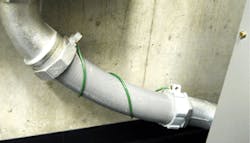Can you identify the Code violation(s) in this photo?
Hint: Taking the long route
Find the Answer
How well do you know the Code? Think you can spot violations the original installer either ignored or couldn’t identify? Here’s your chance to moonlight as an electrical inspector and second-guess someone else’s work from the safety of your living room or office. Can you identify the Code violation(s) in this photo?
‘Tell Them What They’ve Won...’
Using the 2011 NEC, correctly identify the Code sections that show violation(s) in this month’s photo — in 200 words or less — and you could win something to put in your toolbox. E-mail your response to [email protected], and we’ll select three winners (excluding manufacturers and prior winners) at random from the correct submissions. Winners will receive a set of insulated hand tools from Ideal Industries, Inc., valued at more than $125.* The set includes 9.25-in. insulated side-cutting pliers, 10-in. insulated tongue-and-groove pliers, and a 0.25-in. 3 6-in. insulated screwdriver. (* Please allow six to eight weeks for delivery of tools.)
SEPTEMBER WINNERS
We had three winners this month: Brandon McCoy, foreman, G&G Systems, Henderson, Nev.; Larry Lowe, reliability engineer, Flint Ink, Huntington, W. Va.; and Bill Butler, estimator/project manager, Bayshore Electric, Inc., Daytona Beach, Fla. Each one of them had some interesting observations on this bird nest-filled conduit body — the best one being, “the feathers and twigs in this LB do not qualify as sealing material.”
The missing cover for the conduit body is a violation of 314.17(A) and 314.28(C). This exposes the cable to corrosion and deterioration (and even wild birds!), which is a violation of 300.6. As noted above, feathers and twigs do not qualify as an approved sealing material per 300.7. The conductor exiting the conduit body is now exposed and unprotected from physical damage, which is a violation of 300.4 and 300.5(D)(2). The open and exposed holes in the brick wall at both locations in this photo also create a potential fire hazard. The lack of approved fire stop materials at these locations also creates a violation of the requirements of 300.21. As is normally the case with these photos, we can also cite this installation for not being done in a neat and workmanlike manner (110.12).
About the Author
Joe Tedesco
Tedesco served the industry in many roles during his career. He was a director, senior electrical code instructor for National Technology Transfer, Inc. and American Trainco, Inc.. He was also a codes, standards and seminar specialist for the International Association of Electrical Inspectors and an electrical field service specialist for the National Fire Protection Association in Quincy, Mass. He ran his own business as an NEC consultant and is a Massachusetts licensed master electrician and journeyman electrician and certified electrical inspector (one and two family 2A; General 2B, and Plan Review, 2C). Tedesco also wrote articles for CEE News and EC&M (Code Violations Illustrated and What's Wrong Here?) for more than 15 years and helped launched the Moving Violations video series.
